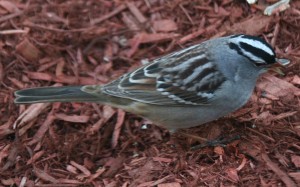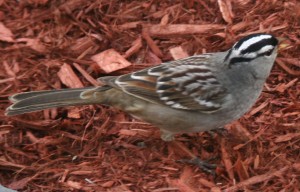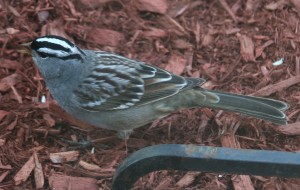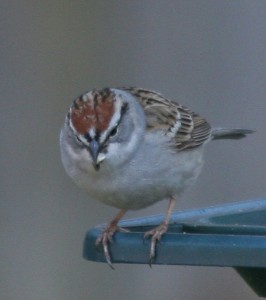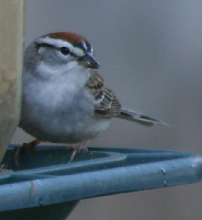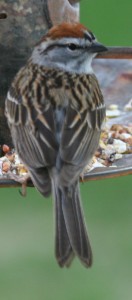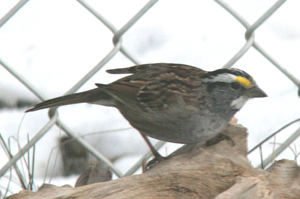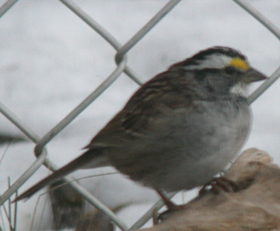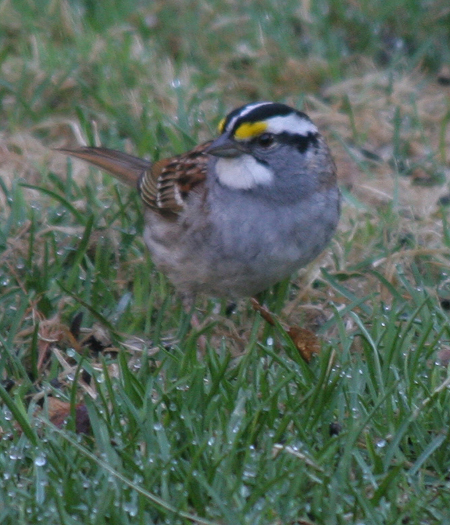House Sparrow Information
General:
The House Sparrow (Passer domesticus) is one of the most common bird species in North America, although it is a non-native species. These sociable and tame birds can be spotted in backyards hopping along the ground pecking at seed as well as on city streets feeding on crumbs. This species has a long running relationship with humans and has come to rely heavily on human populations for survival. House Sparrows have healthy and stable populations across a wide geographic range and are listed as Least Concern on the IUCN Red List.
House Sparrows are generally tame and sociable birds, within their flocks and with people, especially during the winter. Because these birds live in social communities, methods of communication have been developed to relay dominance, submissiveness, nervousness, courting and aggression. They often feed together to minimize predation and their flocks have social structures that are similar to that of chickens. Male House Sparrows with larger black throat 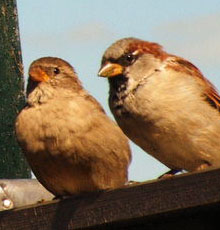 patches tend to be dominant over males with smaller bibs. During the courting and breeding season females tend to be more assertive, but males are the dominant sex in the flock throughout the rest of the year. Nervousness is indicated by a flick of the tail. Aggression is communicated by a crouched posture with thrust-forward head, spread wings, erect tails and ruffled feathers (in extreme situations.) In a courting display, a male will puff up his chest and open his wings and tail, hopping stiffly and bowing up and down in front of the female4. In addition to social dominance and behavioral communication, House Sparrows are a noisy species that uses a number of simple vocalizations to verbalize warnings, threats and defense, or to attract a mate. The most common sounds include a chatter (often used by females toward her mate or to chase away competing females,) a cheep (used in a series to attract mates and in a flock to communicate submissiveness,) wheezy calls, and chirps.
patches tend to be dominant over males with smaller bibs. During the courting and breeding season females tend to be more assertive, but males are the dominant sex in the flock throughout the rest of the year. Nervousness is indicated by a flick of the tail. Aggression is communicated by a crouched posture with thrust-forward head, spread wings, erect tails and ruffled feathers (in extreme situations.) In a courting display, a male will puff up his chest and open his wings and tail, hopping stiffly and bowing up and down in front of the female4. In addition to social dominance and behavioral communication, House Sparrows are a noisy species that uses a number of simple vocalizations to verbalize warnings, threats and defense, or to attract a mate. The most common sounds include a chatter (often used by females toward her mate or to chase away competing females,) a cheep (used in a series to attract mates and in a flock to communicate submissiveness,) wheezy calls, and chirps.
House Sparrows tend to have more direct and higher flight than native species of sparrows. Their flight is continuous and lacks periods of gliding5. Because of their stature and short legs, House Sparrows can most often be seen hopping on the ground rather than walking.
House Sparrows tend to have life spans of just a few years. However, there are recorded instances of wild individuals living as long as 13 to 15 years.
Description:
House Sparrows are unrelated to other species of sparrows that are native to North America, such as the white-crowned sparrow, and therefore, differ in appearance. They may be identified by their shorter, stockier appearances, accentuated by full chests, shorter tails and legs, large round heads and shorter, thicker beaks. House Sparrows reach a mature size of 5.9” to 6.7” in length and 27g to 29g in weight. Their wingspan, when full grown, is 7.5” to 9.8”1. Geographic variations exist due to the House Sparrows immense range. Colder climates tend to produce larger birds with shorter wings and legs, whereas populations with darker plumage tend to be found in humid climates2.
Coloration may differ between sexes and during different seasons. Both sexes generally have buff, brown and black stripes on their backs, although males tend to be more brightly colored, with gray heads, black patches or “bibs” on their necks and white cheeks. Females are generally dull tan-gray, with gray undersides, buff eye-stripes, and a bill that is more yellow than males. During the summer, breeding males will display a black bill, mask, throat and chest, a gray cap, and a white stripe on their shoulders. Their main coloring is a reddish-brown with black streaks. Non-breeding males lack the vibrant reddish-brown coloration because those feathers become obscured by gray feather tips. Non-breeding males also have less black on their throats and chests, and yellow at the base of their bills3. This seasonal variation is due to an annual molt. Juveniles are plain in color, in appearance to females.
Habitat:
House Sparrows tend to be found in areas inhabited or affected by humans, including cities, towns, suburbs, farms, and parks. Because of their dependency on humans, House Sparrows are unable to survive in areas such as uninhabited woodlands, alpine forests, grasslands, or deserts. In extreme climates House Sparrows must maintain a close proximity to human populations for survival.
In their habitats House Sparrows (and their eggs and young) are vulnerable to a number of predators, such as hawks, owls, cats, dogs, raccoons and snakes. Their tendency to forage in flocks increases their awareness and survival rates.
Location:
They are year round residents of their native environments of Eurasia and North Africa. Introduced, invasive populations are also non-migratory and thrive in South Africa, South America, New Zealand, Australia, and North America. Their lack of migration increases survival rates because of a diminished demand for energy and exposure to predators.
The House Sparrow was introduced to Brooklyn, New York in 1851, when 100 birds from England were released. This may have been done to control certain insect populations or to make the area more familiar to European immigrants. By the turn of the century, their populations had spread to the Rocky Mountains. Additional populations were released in San Francisco and Salt Lake City in the 1870’s, expanding this species range across North America (excluding Alaska and northern parts of Canada6.)
Diet:
The house sparrow is an omnivorous ground forager that spends much of its time hopping along the ground pecking at food. They have also been known to steal food from larger species of birds and drink nectar from flowers. Their diets consist mainly of grain and seed (corn, oats, sorghum, wheat,) crumbs and food waste, ragweed, grasses, buckwheat, commercial birdseed, and insects.
Reproduction:
House Sparrows are monogamous and form breeding pairs each season, with nesting beginning in late winter and courtship occurring in early spring. Nesting may begin only a few days before the first egg is laid. They prefer to build their nests in man made structures such as the walls of buildings, on streetlights, in nest boxes or in the eaves of houses. They have been known to evict other birds from their nests, destroying existing eggs and physically attacking the opposing birds. House Sparrows tend to reuse their nests. And have been known to aggressively defend their nesting areas.
Both males and females construct the nests by stuffing their nesting cavities with dry vegetation until the hole is nearly full and then lining the interior with softer materials such as string, paper, and feathers. House Sparrows often nest in close proximity to each other, the nests sometimes sharing a common wall.
A House Sparrow may lay up to 4 broods in a year, each containing between 1 and 8 white/light-green/blue-white eggs, speckled with gray or brown and approximately 7/8” in length. Parents alternate incubating the eggs for a period of 10 to 14 days. Young chicks are born naked and uncoordinated, with closed eyes. During the nestling period of 10 to 14 days both parents feed the chicks through regurgitation. House Sparrows reach sexual maturity by around 9 months of age.
Notes of Interest:
House Sparrows enjoy dust baths and can often be spotted coating their bodies with dust and dirt. They also take baths in puddles or shallow water, using a similar flicking motion to coat their feathers.
Because the house sparrow is so numerous and tame, they are often the subject of avian biological studies and have been the subject of nearly 5,000 scientific papers7.
Although House Sparrows are common and numbers are stable, some populations have experienced a sharp decline, possibly due to farming practices, and changes in land-use. Despite this, they are not considered threatened and are not protected under any laws or regulations.
Footnotes
1. http://www.allaboutbirds.org/guide/house_sparrow/id
2. http://animals.nationalgeographic.com/animals/birding/house-sparrow/
3. http://www.allaboutbirds.org/guide/house_sparrow/id
4. http://www.allaboutbirds.org/guide/house_sparrow/id
5. http://animaldiversity.ummz.umich.edu/accounts/Passer_domesticus/
6. http://www.allaboutbirds.org/guide/house_sparrow/id
7. http://www.allaboutbirds.org/guide/house_sparrow/id
http://www.allaboutbirds.org/guide/house_sparrow/id
http://animals.nationalgeographic.com/animals/birding/house-sparrow/
http://animaldiversity.ummz.umich.edu/accounts/Passer_domesticus/
http://www.thepoultrysite.com/articles/848/understanding-and-control-of-house-sparrows
